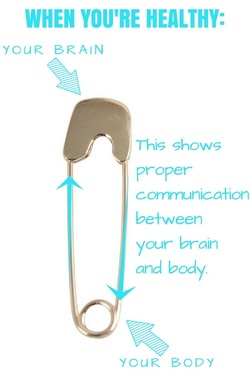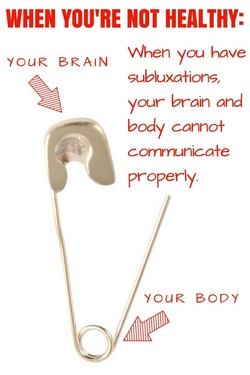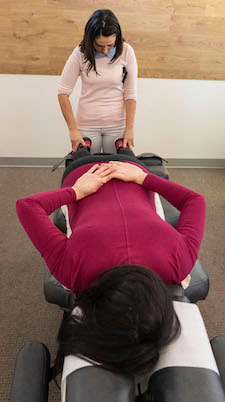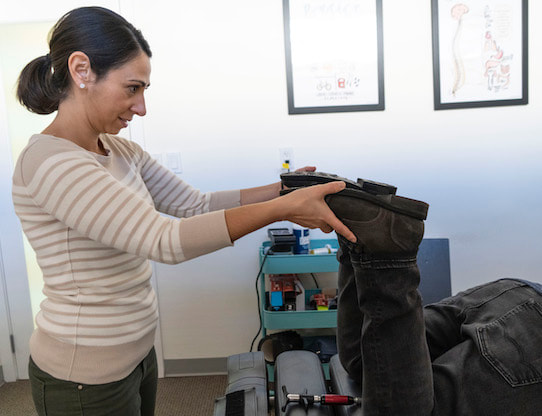| Why do we compare your leg lengths at the beginning of every adjustment? Activator Method chiropractors are not checking your leg lengths for an anatomical discrepancy of your legs (one leg bone that’s longer than the other), we’re looking for a functional leg length difference. When we find one leg that looks shorter than the other, it doesn’t always mean that you have a “real” short leg. Your brain and body are always in constant communication with each other. When your spine has misalignments (or imbalances in your joint motion), this causes a miscommunication between your brain and body (AKA: your brain senses that something’s not right), and as a result, the muscles in one leg will tighten to cause one leg to appear shorter than the other. It’s one way your body neurologically compensates for imbalances or dysfunction in your spine and nervous system. During your adjustment, we’re able to see your legs balance as a result of addressing the areas of stress or dysfunction in the body. This is one of the ways we can see a functional change in the body right away, and we know that once we clear out these imbalances, your body and nervous system is more equipped to heal and function better! |
|
Are you a science nerd?! Check out the research! https://www.activator.com/category/leg-length-inequality/
0 Comments
These are some of the most popular questions we get before a patient comes to see us for the fist time! 1. How long is each visit? During your first visit at our office, you will spend about 30-45 minutes with me. We’ll go over your current health issue and past health history, do a thorough evaluation and exam to learn more about your condition and your general biomechanics. You may get your first adjustment that day. (Or some patients are referred out for x-rays before a full adjustment can be performed. This is based on your health/injury history and/or your exam findings). Your second visit will last about 20-30 minutes. This is when I will go over your exam findings with you, and when we’ll determine the appropriate care plan schedule that fits your needs. Your regular adjustment visits will last about 15-20 minutes.
3. What techniques are used? I use a combination of techniques that’s specifically tailored to each individual patient. (I recently had a student shadowing me one day, who at the end of the morning turned to me and said, “wow - you did something different with every patient today!”) I use the Activator Method to analyze and adjust the spine to start, and add in some different techniques (gentle manual adjusting, drop-table, soft tissue techniques, etc) if needed. This creates a unique approach and experience for each individual patient who steps in our door. 4. Do I have to be in pain to start care? Of course not! It’s always a good idea to get your spine checked by a chiropractor BEFORE there’s a pain issue or injury. We have many patients who have heard about the benefits of chiropractic as part of their overall health. Usually, these patients do not have to be seen as frequently as patients who are injured or having a current pain issue. 5. Do you take insurance? We are in-network with some insurances (UnitedHealthcare, Oxford, Connecticare, Blue Cross/Blue Shield) and out of network with others. During your first visit, our Beth (our office manager) will check your benefits and let you know what your responsibility per visit will be. We electronically file insurance claims on your behalf. If you don’t have insurance or opt no to use it, our out of pocket fees are reasonable, and similar to many insured patients’ co-pays or co-insurances. 6. Can chiropractic help with _________? Maybe! Chiropractic in its truest form is not a “treatment” for anything specific, it helps improve the function of your own body so it can be better equipped heal itself! Do you have any other questions? Ask us in the comments section below, or give our office a call at 203-355-2830.
Research tells us it can! At this time of year, everyone’s talking about their Labor Day Weekend plans, but in our office, we talk about a DIFFERENT kind of “Labor Day” throughout the whole year… Did you know research has shown that chiropractic can help your labor and birth? 1. Shorter Labor Times: A retrospective review of statistics reported that primigravida (pregnant for the first time) women who seek chiropractic care throughout gestation have, on average, a 25% shorter labor time! Multiparous women (meaning they have given birth at least once already) who seek chiropractic care throughout their pregnancy have, on average, 31% shorter labor times. (1,2) 2. Help with Fetal Positioning: As discussed in our post about the Webster Technique, one of the treatment goals of chiropractic during pregnancy is meant to reduce fascial restraint within the musculoskeletal structures of the pelvis to promote biomechanical balance. Chiropractic can help decrease tension in the pelvis so the baby is able to move more freely and get into the best possible position for birth! (3) 3. Relaxation of Pelvis Floor Musculature: One recent study studied the change in tone of the pelvic floor musculature (specifically the levator hiatal area) after a chiropractic adjustment. This is the area that needs to be able to stretch during a vaginal delivery. The researchers saw that the area of the levator hiatal area was increased significantly after 1 adjustment, and this demonstrated a more relaxed state of the pelvic floor muscles. (The interesting thing with this study was that there was no change in muscle tone to the non-pregnant patients that were participants in this study, which says that this change in tone with chiropractic care may be pregnancy related only.) (4) 4. Less Pain: Research has shown that chiropractic care throughout pregnancy can be helpful at reducing pain symptoms throughout pregnancy. The authors on one study also noted that chiropractic care may significantly decrease the incidence of “back labor,” which can significantly increase pain and complications of labor and birth. The relative risk of experiencing back labor was almost 3 times greater (!) if back pain was experienced at all during the pregnancy. (5) Are you pregnant? Contact us to set up your appointment with Dr. Cristina to see if intrauterine constraint and/or musculoskeletal imbalance are affecting your pregnancy.
Sources: 1. J.M. Fallon. Textbook on chiropractic & pregnancy. Arlington, VA: International Chiropractic Association; 1994: 52, 109. 2. Fallon J.M. Chiropractic and pregnancy: a partnership for the future. ICA Int Rev Chiropr. 1990;46(6):39–42. 3. Ohm J. Chiropractors and midwives: a look at the Webster Technique. Midwifery Today. 2001;58:42. 4. Haavik H, Murphy BA, Kruger J. Effect of Spinal Manipulation on Pelvic Floor Functional Changes in Pregnant and Nonpregnant Women: A Preliminary Study. J Manipulative Physiol Ther.2016;39:339-347. 5. Diakow P.R.P., Gadsby T.A., Gadsby J.B., Gleddie J.G., Leprich D.J., Scales A.M. Back pain during pregnancy and labor. J Manipulative Physiol Ther. 1991;14(2):116–118. Let's talk BACKPACKS!
What are some signs that your child is wearing his or her backpack incorrectly?
Practical Tips for Reducing Backpack Stress on the Spine
If your child exhibiting some of the signs of spinal stress from incorrect backpack use, chiropractic may be able to help! Call us at 203-355-2830 to schedule an appointment for an evaluation with Dr. Cristina.
For the baby, the surrounding walls of the uterus tighten with pelvic imbalance, becoming more and more like tight bed sheets that restrict her motion. The chiropractic adjustment to the pelvis releases tension to the ligaments and uterus so that the baby can move freely and assume the best possible position for birth. It is important to realize that many pregnant women are seeking ICPA doctors throughout their pregnancies to utilize the many additional benefits of the Webster technique. For every stage of pregnancy, this adjustment reduces interference to the nervous system—a vital benefit to improve physiology for both Mom and her baby. When Mom’s physiological function is at its best, the baby’s development is optimized. Balancing the pelvic bones, muscles and ligaments and improving normal physiology sets the stage for a natural birth. Chiropractic care and the Webster technique allow for safer, easier births! This excerpt was taken from the ICPA Member Newsletter, 2019. For more information, visit discoverkidshealth.com. Call our office today at 203-355-2830 to set up your prenatal consultation and evaluation!
Everyone deserves to relax at the beach, but we can’t let our spinal health go by the wayside! It only takes 10-15 minutes in one position for our ligaments to begin to lose elasticity, which can put stress on your spine and nervous system. These tips can help prevent injuries and encourage spinal health!
 Chiropractic and the "Safety Pin Cycle" Sometimes, when we’re thinking about the way our bodies work, we can think if it like a safety pin. The top, or the clasp of the safety pin, is like our brain, which generates nerve impulses to control and regulate our entire body. We can look at the edges and the hinge of the safety pin as your body. Our brain is like a big computer that sends messages through the spinal cord and nerves that control every action in our cells, tissues and organs. Then, nerve impulses are sent back up, from your body to your brain. These messages let your brain know that your body is working correctly. When your brain and body are communicating properly, we can compare this to a closed safety pin. Proper communication between the body and brain is the definition of TRUE HEALTH.  Many things can interfere with nerve impulses either to or from your brain. Sometimes, misalignments in your spine (subluxations) can be the cause of these altered messages to or from your brain. When you have subluxations in your spine, we compare this to an open safety pin - it means your brain and body aren’t communicating property. When this happens, your organs and tissues won’t work right, and the result is poor health and dysfunction in your body. How do we get these subluxations in the first place? They’re the result of physical, chemical and emotional stress in our lives. Chiropractors who focus on the holistic spinal care locate and reduce subluxations with safe and natural adjustments. These adjustments allow the body and brain to communicate properly, which leads to better health and well-being, because the body now has the ability to heal and function without interference. Do you think you may have spinal misalignments causing a miscommunication between your brain and the rest of your body? Call our office today at 203-355-2830 or request an appointment online to see if subluxations could be a cause of dysfunction in your body.
 Most of us spend the majority of our days at work, and for about 80% of the United States population, that can mean sitting for an average of 7 hours a day. Sitting for this long everyday has not only been linked to an increase in pain, but also heart disease, weight gain, diabetes, brain fog, osteopenia and even certain cancers. Check out this infographic from the Washington Post for details on the negative effects of sitting all day. These 5 tips can help combat the negative effects of sitting all day AND help break up the workday so you can stay more alert and focused! (What boss wouldn’t want that for their employees?!) 1. Take breaks! I tell my patients everyday, make sure you’re taking breaks though the workday. You should be getting up out of your chair for at least 10 minutes every hour. This could mean standing up when you’re taking a phone call, making extra trips to the copier, or simply getting up to take a break and stretch. Can’t remember to get up every hour? There are some great smart phone apps our there like Stand Up! – These will bing or buzz your phone once an hour to remind you to get up and get moving! Bonus Tip: do some "deskercises" during your breaks - get some great ideas here. 2. Change up your workstation – standing desks are becoming increasingly popular for good reason. Not only can it combat the hazards of sitting all day, but it can also help us burn calories, tone muscle, increase blood flow and improve metabolism. [2] In the office, I notice a significant difference in my patients who use stand-up desks compared to the ones who sit all day – the ones who stand have healthier spines and end up maintaining their adjustments for longer than the ones who sit. Don’t feel like standing all day? Swap out your desk chair for an exercise ball instead! It will force you to maintain good posture and activate your core. 3. Use Proper Ergonomics – If you have to sit in your desk chair, make sure you’re using proper ergonomics. Your feet should be touching the floor with your knees and hips at 90 degrees. (You may need to place something under your feet to prop them up if you’re petite like me!) Your monitor should be directly in front of your head while it’s at a neutral position (at a distance that doesn’t require you to lean in or strain to see the screen). Shoulders should be relaxed and your forearms should be parallel to the floor. Some other great tips on ergonomics can be found here. 4. Find a “Wellness Buddy” – Partner up with a co-worker who wants to start making some healthy changes in his or her life, too. Check in on each other throughout the workday – this could be a reminder for a stretch break, reminder to stand up, or a quick walk to the other person's desk. Research tells us that working out with a partner helps us perform better and stay motivated. [3] 5. Visit Your Chiropractor – Work can be stressful, and this stress can unfortunately lead to stress and damage on your spine and nervous system. Chiropractic adjustments remove areas of interference to your nervous system so your body can more easily adapt to these external stresses, which can prevent problems down the road. Regular chiropractic care has been linked to some great benefits for the workplace including less pain, increase in creativity [4] and improved quality of life [5]. Don’t have a chiropractor yet? Give us a call at 203-355-2830 or request an appointment online to set up your spinal check-up today. Sources:
1. Matthews CE, George SM, Moore SC, Bowles HR, Blair A, et al. (2012) Amount of time spent in sedentary behaviors and cause-specific mortality in US adults. Am J Clin Nutr 95: 437–445. doi: 10.3945/ajcn.111.019620 2. http://www.juststand.org/tabid/816/language/en-US/default.aspx 3 .Aerobic exercise is promoted when individual performance affects the group: a test of the Kohler motivation gain effect. Irwin, B.C., Scorniaenchi, J., Kerr, N.L. et al. Kinesiology, Michigan State University, East Lansing, MI. Annals of Behavioral Medicine 2012;44(2):151-9. 4. Masarsky, C.S. and M. Todres-Masarsky. “Effect of a Single Chiropractic Adjustment on Divergent Thinking and Creative Output: A Pilot Study, Part I.” Chiropractic Journal of Australia, 2010. 5. Mark J. Marino and Phillippa M. Langrell. A Longitudinal Assessment of Chiropractic Care using a Survey of Self-Rated Health Wellness & Quality of Life: A Preliminary Study. Vol 3(2):1-9.  Can you believe it? It’s already back to school time in Connecticut this week… The start of school also means the return of heavy backpacks, which to me as a chiropractor, means the return of increased spinal stress for school-aged kids and young adults. Here are some helpful backpack-wearing tips that will help minimize spinal stress: 1. Wear both straps evenly, and avoid the one-strap styled back packs. Uneven distribution of the load causes postural compensations and spinal stress. 2.When putting on and removing backpacks, bend at the knees or put on the backpack from a higher level, such as on a desk or table. Sudden twisting motion adds to the potential of injury – especially in the lower thoracic/upper lumbar spine. 3. Arrange the backpack so it rests evenly in the middle of the back. Shoulder straps should be adjusted to allow the child to put on and take off the backpack without difficulty and permit free movement of the arms. Straps should not be too loose, and the backpack should not extend below the lower back. 4. Keep the load at 10-15% or less of the student’s body weight. 5. Carry only those items that are required for the day. Students (or parents) may be able to request additional copies of textbooks (or digital copies!) that can be kept at home instead of hauling heavy books back and forth from school. 6. Organize the contents of the backpack by placing the heaviest items closest to the back. When was the last time your child had a spinal check-up? Call us at 203-355-2830 to schedule one today! And just in case you missed it, here's a great video featuring some parents who are VERY excited about school starting... Modified excerpt from: Is Your Child’s Backpack a Source of Spinal Stress? By Jeanne Ohm, DC
Read more in Pathways: www.pathwaystofamilywellness.org |
AuthorDr. Cristina shares some insight about the benefits of Chiropractic as a vital part of your healthy lifestyle! Archives
August 2022
Categories
All
|
















 RSS Feed
RSS Feed
